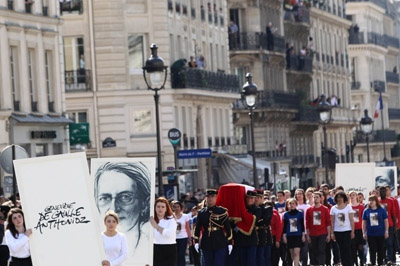 Entering the Pantheon
Entering the Pantheon A national ceremony celebrating Republican values
On May 27th, four major figures of French Resistance entered the Pantheon. This ceremony is almost a rite in the French Republic. It is purely symbolic, but never stripped of underlying political motives.
Promoting the Resistance and Republican values
On May 27th, four historical personalities of French Resistance entered the Pantheon. Journalist Pierre Brossolette and Minister for Education Jean Zay both died in Spring 1944 and are major figures of the 1930's. Ethnologist Germaine Tillion and activist Geneviève de Gaulle-Antonioz became friends during their deportation in Ravensbrück and represent the next generation: both were committed intellectuals during the second half of the 20th century.
The common point of all those persons is their heroic resistance against Nazi oppression during WW2. In total opposition with the collaborationist attitude of marshall Pétain, Brossolette, Zay, Tillion and de Gaulle-Antonioz wrote a glorious page of French history. As such, they entered the Pantheon, a republican and patriotic temple. In his celebration speech, the French president underlined that the "four stories give a face and a body to the Republic": they personify the values of the French motto, liberty, equality and fraternity.
A ceremony that glorifies men from the French Revolution
"To the great men, the grateful homeland". The motto is written on the pediment of the Pantheon. It illustrates the role of this impressive neoclassic monument: to glorify national heritage by sacralising the figure of a great man.
The creation of the building dates back to Louis XV. At the time, it was a catholic church dedicated to Saint Genevieve. But the French revolution imposed the Republican rite of entering the Pantheon in order to immortalise those who helped bring down the Old Regime. During the 19th century, the monument was both used as a church and a secular monument. The second model ended up winning after the triumph of the Republic.
The only condition to enter the sanctuary of the great men is to have the French nationality. Political figures such as Jean Jaurès or Jean Monnet rest next to writers such as Victor Hugo and Emile Zola, scientists such as Pierre and Marie Curie or even soldiers from the Napoleonian Wars fallen since then in the basements of History.
The list is overwhelmingly made up of male names. Before Tillion and de Gaulle-Anthonioz, Marie Curie was the only woman to have entered the Pantheon and joined 70 men. A public consultation carried out by the government underlined this lack of representativeness: the consultation was about the figures the French wanted to see enter the Pantheon.
A symbolic ceremony and a political act
The President always has the final decision to let persons who marked the History of France enter the Pantheon. As such, it has a strong political stake. Choosing one or several persons allows the president to put his mandate on the same line has the figures he chose. François Mitterrand paid a tribute to no less than seven figures he admired, from philosopher Nicolas de Condorcet to the founding father of the UE Jean Monnet.
During the ceremony, the speech by the current president is often a good opportunity to create bonds between figures in the Pantheons and the current situation. As such, François Hollande called for a "resistance duty" that takes a particular taste in the context of rise of extremism. He did not hesitate to compare the "freedom that pushed Brossolette to join the Resistance" to the "French who rose on January 11th" during the march that followed the terrorist attacks against newspaper Charlie Hebdo. A symbolic union that shows the advantage to transcend partisan divisions by joining left-wing Pierre Brossolette to right-wing Geneviève de Gaulle-Antonioz.
Photo credits: © Présidence de la République